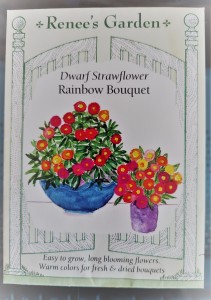 Every year as spring approaches, one of my favorite seed companies sends me a free sample of a new variety, along with promotional literature. Sometimes the seeds are for something that I am unlikely to grow—like the latest and best kohlrabi. I happily donate seeds like that to a vegetable-growing friend. This year the seeds are for something that I will certainly grow—strawflowers, known botanically as Xerochrysum bracteatum.
Every year as spring approaches, one of my favorite seed companies sends me a free sample of a new variety, along with promotional literature. Sometimes the seeds are for something that I am unlikely to grow—like the latest and best kohlrabi. I happily donate seeds like that to a vegetable-growing friend. This year the seeds are for something that I will certainly grow—strawflowers, known botanically as Xerochrysum bracteatum.
Someone somewhere grows a lot of strawflowers for the crafts and dried flower market. Large craft merchandisers offer them in bunches. So do suppliers of dried flowers, flower arrangements and decorative floral items like wreathes and swathes. Strawflowers fall under the category of “everlastings”, and while absolutely nothing, except possibly fruitcake and some plastics, lasts forever, dried strawflowers can look good for months, if not years.
I have admired strawflowers for my entire gardening career, but have never grown them until now. They are annual, sun-loving members of the daisy or compositae family, and for maximum enjoyment and flower production, you should start them inside about six to eight weeks before the last frost date for your particular area. Since my last frost date is “tax day”, April 15, it is time for me to get cracking. In keeping with my recent resolution to try raising seedlings in eggshells, I have been cracking eggshells and have saved a whole carton of them. They are ready and waiting for the weekend, when I will start my strawflowers.
Like the platypus and the echidna, Xenochrysum bracteatum—fomerly known as Helichrysum bracteatus–is indigenous to Australia. Unlike those species, it made its way to England in 1791, only eight years after the establishment of the first British penal colony on the island continent. The species got a big boost in the mid nineteenth century when Herren Ebritsch, a German botanist took and interest in breeding them. Ebritsch expanded the range of colors to the broad spectrum of white, yellow pink, red, orange, and purple shades available today.
Strawflowers grow up to three feet tall, with long, relatively narrow leaves that are not ugly, but are nothing to write home about either. The plants’ real glory is the array of flowers that appear at the tops of the stems. The papery “petals” are actually bracts or specially adapted leaves. The true flowers are tiny and reside happily and unobtrusively in the middle of each bloom.
I have occasionally seen strawflower plugs in large garden centers, but the majority of those who grow them start from seed. Most vendors sell mixed color assortments like ‘Swiss Giant Mix’ or ‘Sultane Mix’. A few seed companies also carry single-color selections. For smaller gardens and containers, breeders have come up with shorter cutltivars. My free seeds are the ‘Rainbow Bouquet’ mix for dwarf strawflowers. These grow only 18 inches tall with two inch flowers in the usual array of colors. ‘Tom Thumb’ mix is even shorter, topping out at 15 inches tall.
Tall or short, strawflowers all thrive on well-drained soil and lots of sun. Very light shade is fine as well, but the number of blooms will be fewer. If you are starting from seed, order now from online vendors, or seek out the seed racks at local garden centers. Follow the directions on the seed packets, but generally use small containers, like eggshells, degradable pots or plastic starter trays and sow about three seeds per individual container. Use fresh potting mix and do not cover the seeds, as they need light to germinate. Add a tablespoon of water per pot or group of seeds and place on a sunny windowsill, or under plant lights if you have them. Water carefully as needed, but do not swamp your seedlings. When the seedlings are an inch or more above the soil surface, thin them by clipping off the weaker ones. This seems inhumane, but allows the strongest seedlings to get the full benefit of the available light and nutrient supply.
After the last frost date, harden off the seedlings by placing the pots in a sheltered outdoor area for a week or so. Then transplant to garden beds or containers.
Once they are established, strawflowers can tolerate drought better than many annuals, so save your water for the stocks and larkspur. Pick the flowers regularly, or deadhead them, as doing so stimulates additional blooms. If you are drying your strawflowers, hang them upside down in a well ventilated space for a week or so. They will retain most of their color and be ready for whatever projects you have in mind.
I once saw a full-size Christmas tree at a botanical institution decorated entirely in dried flowers. Strawflowers played a starring role. They are also lovely on wreathes and swags.
To find a good selection of strawflower seeds, go to Johnny’s Selected Seeds, P.O. Box 299, Waterville, ME 04903; (877) 564-6697; www.johnnyseeds.com.
